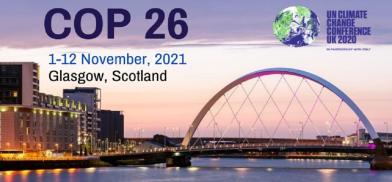Glasgow climate meet: A lot of tall talk - and deafening silence
The world climate did not become better after the Paris meet and it will not become better after the Glasgow meet too

The Glasgow Climate Meet (COP26) has ended with countries voicing their respective concerns over climate changes. It was warned that some regions would fall off the world map by 2040 if the emission level of toxic and global warming gas is not eliminated. Between the earlier Paris Climate Meet and now at Glasgow, no significant difference in the emission levels was seen.
Prior to Glasgow, China said it will have zero emissions by 2060. In Glasgow, the US and some European countries said they will achieve the target by 2050. India pledged to have zero-emission by 2070. While promises were galore, no convincing solutions were arrived at. To attain zero-emission, the primary requisite is that production and consumption of crude oil, coal and natural gas have to be brought down to nil level, or at least drastically cut.
Difficult global scenario
The world’s present consumption of coal is around 7 billion tonnes per annum, of crude oil around 91 million barrels per day, and of natural gas around 3.8 trillion cubic meters per annum. It will be a herculean task to reduce their consumption drastically.
Crude oil: OPEC countries, Russia, Venezuela and a few others including the US cannot afford to reduce crude oil output to any significant extent as their economy is considerably dependent on it.
Coal: Countries like China, India, Indonesia, South Africa and Australia hugely produce and consume coal. They cannot reduce consumption without seriously upsetting their national economies. Coal’s share in India’s power generation is now about 70 percent. India has distanced itself from the global alliance on phasing out coal by 2030-40 amid growing energy needs. The largest polluting countries including the US and China did not sign an agreement to phase out coal power.
Limitations of renewable power: It is said that renewable energy (wind, solar and hydro) should be promoted to reduce the use of fossil fuel such as coal, crude oil and natural gas. India promised it will increase the renewable energy power to 500 GW by 2030. But renewable power is seasonal and weather dependent. So, it cannot be a substitute for fossil fuel in any significant manner.
Nuclear power: It was suggested that nuclear power is eco-friendly and nuclear power generation should be substantially increased to substitute fossil fuel. While countries like France have large share of nuclear power to meet power needs, Germany has decided not to set up any more new nuclear power plants. There is worldwide concern about safety issues regarding nuclear power plants.
Electric vehicles the answer?
Electric vehicles: World over, the production of electric vehicles is being increased at a feverish pace, expecting that electric vehicles are eco-friendly and will not emit sulphur dioxide, carbon dioxide and nitrous oxide. Lithium-ion battery is an essential component of the electric vehicle and the batteries have to be charged regularly, requiring power from an external source. Power for charging lithium-ion batteries has to come from thermal power stations where fossil fuel will be used.
Hydrogen: Hydrogen is an eco-friendly gas that can be used as fuel and feedstock. It can be an acceptable substitute for fossil fuels in a big way if it can be produced on a large scale in an eco-friendly manner. A number of hydrogen plants are being set up in the world. Hydrogen is produced as grey hydrogen (from natural gas), brown hydrogen (from coal), and green hydrogen (by water hydrolysis).
The production of hydrogen from natural gas is being carried out in a big way. However, natural gas is methane. In the production, processing, storage and transportation of natural gas, methane emission takes place; methane is a toxic gas. Therefore, the production of grey hydrogen cannot be considered entirely eco-friendly.
Production of green hydrogen by water hydrolysis is eco-friendly. One kg of hydrogen production requires 48 kwh of power and water electrolysis is a power-intensive process and expensive. Power for water hydrolysis has to come from renewable energy or thermal power plants using fossil fuel. While power from renewable energy is eco-friendly, adequate power from renewable energy sources will not be available for large-scale green hydrogen production. The global hydrogen industry appears to be too far away to meet the global needs for 100 percent substitution of fossil fuel.
Methane emission: There is a large amount of methane gas production from the livestock population in the world. There is no way of collecting the gas from millions of cows and buffaloes. Methane emission also takes place from use of natural gas. No tangible and effective solutions have been evolved to get rid of methane emissions.
Carbon dioxide capture and storage: A lot of research is going on to capture the carbon dioxide emission and either use carbon dioxide for production of derivative products or pump it into the soil. However, all such work is at a formative stage.
Will the world be different post-Glasgow?
The world climate did not become better after the Paris meet and it will not become better after the Glasgow meet too. Tall talk and protests are not sufficient strategies to sort out the impending global climate crisis. The long story can be cut short by noting that while developing countries have asked the rich nations to provide $1 trillion to them to help them cut emissions, the request has been met with a deafening silence.
(The writer is a Trustee, NGO Nandini Voice for the Deprived, Chennai. The views are personal.)









Post a Comment